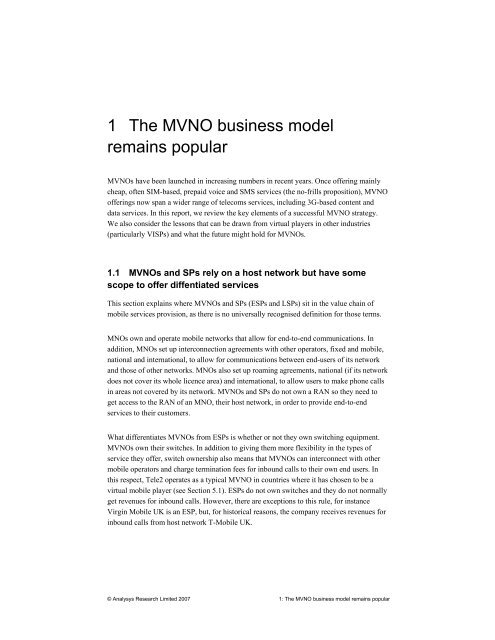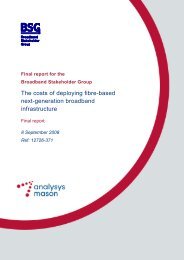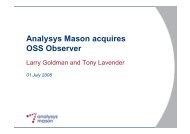1 The MVNO business model remains popular - Analysys Mason
1 The MVNO business model remains popular - Analysys Mason
1 The MVNO business model remains popular - Analysys Mason
- No tags were found...
Create successful ePaper yourself
Turn your PDF publications into a flip-book with our unique Google optimized e-Paper software.
1 <strong>The</strong> <strong>MVNO</strong> <strong>business</strong> <strong>model</strong><strong>remains</strong> <strong>popular</strong><strong>MVNO</strong>s have been launched in increasing numbers in recent years. Once offering mainlycheap, often SIM-based, prepaid voice and SMS services (the no-frills proposition), <strong>MVNO</strong>offerings now span a wider range of telecoms services, including 3G-based content anddata services. In this report, we review the key elements of a successful <strong>MVNO</strong> strategy.We also consider the lessons that can be drawn from virtual players in other industries(particularly VISPs) and what the future might hold for <strong>MVNO</strong>s.1.1 <strong>MVNO</strong>s and SPs rely on a host network but have somescope to offer diffentiated servicesThis section explains where <strong>MVNO</strong>s and SPs (ESPs and LSPs) sit in the value chain ofmobile services provision, as there is no universally recognised definition for those terms.MNOs own and operate mobile networks that allow for end-to-end communications. Inaddition, MNOs set up interconnection agreements with other operators, fixed and mobile,national and international, to allow for communications between end-users of its networkand those of other networks. MNOs also set up roaming agreements, national (if its networkdoes not cover its whole licence area) and international, to allow users to make phone callsin areas not covered by its network. <strong>MVNO</strong>s and SPs do not own a RAN so they need toget access to the RAN of an MNO, their host network, in order to provide end-to-endservices to their customers.What differentiates <strong>MVNO</strong>s from ESPs is whether or not they own switching equipment.<strong>MVNO</strong>s own their switches. In addition to giving them more flexibility in the types ofservice they offer, switch ownership also means that <strong>MVNO</strong>s can interconnect with othermobile operators and charge termination fees for inbound calls to their own end users. Inthis respect, Tele2 operates as a typical <strong>MVNO</strong> in countries where it has chosen to be avirtual mobile player (see Section 5.1). ESPs do not own switches and they do not normallyget revenues for inbound calls. However, there are exceptions to this rule, for instanceVirgin Mobile UK is an ESP, but, for historical reasons, the company receives revenues forinbound calls from host network T-Mobile UK.© <strong>Analysys</strong> Research Limited 2007 1: <strong>The</strong> <strong>MVNO</strong> <strong>business</strong> <strong>model</strong> <strong>remains</strong> <strong>popular</strong>
3 Large retailers use their brand andlogistics to cross-sell productsFor large retail companies and consumer brands with a high street presence, launching an<strong>MVNO</strong> can present a significant opportunity. Many such companies are increasinglydiversifying from their former core product areas (such as food and clothing) into sectorssuch as financial services and telecoms. <strong>The</strong> success of Virgin Mobile was attributableprimarily to the combination of a simple, competitive set of tariffs and the strength ofVirgin’s well-established brand. <strong>The</strong> impact of this strategy has not been lost on largeretailers, many of which are keen to carve out a niche for themselves within the mobilemarket.3.1 Retailers have the opportunity to exploit the strength oftheir high street presenceOne of the key assets of major retailers is their presence on the high street and retail parks.Figure 31. shows a comparison of the number of sales outlets owned by several major UKretailers and MNOs.Figure 3.1: Number of sales outlets of major UK retailers and MNOs, 2006 [Source;<strong>Analysys</strong> Research, 2007]TescoSainsbury'sMarks & SpencerMorrisonsVodafoneAsdaO23 UKT-Mobile0 100 200 300 400 500 600UK retail outletsNote: For UK retailers, chart includes outlets of more than 15 000 square feet capacity, which typically offer anextended range of product lines. No outlet data available for Orange.© <strong>Analysys</strong> Research Limited 2007 3: Large retailers use their brand and logistics to cross-sell products
Strategies for <strong>MVNO</strong>s 355.3 Virgin Media will be the only quadruple-play operator in theUKIn July 2006, British triple-play operator ntl:Telewest positioned itself as the sole providerof quadruple-play services by purchasing Virgin Mobile – the largest <strong>MVNO</strong> (in terms ofsubscribers) in the UK. During the third quarter of 2006, the ntl:Telewest group announcedthat it would rebrand itself as Virgin Media from the first quarter of 2007 and that it woulduse its new name across all its services.Prior to its acquisition of Virgin Mobile, ntl:Telewest had become the largest alternativeoperator in the UK, most notably through cable operator ntl acquiring competitorTelewest’s assets in March 2006. ntl:Telewest’s position in the UK communications marketat the end of the first quarter of 2006 is indicated on Table 5.2.Table 5.2: ntl:Telewest’s position in the UK communications market, 1Q 2006 [Source:<strong>Analysys</strong> Research, 2007]ntl:Telewest Broadband Telephony Pay TVSubscribers 2.8 million 4.3 million 3.3 millionShare of the market (%) 25 15 20In addition, the acquisition of Virgin Mobile added 4.5 million customers, which at the endof the third quarter of 2006 was equivalent to a 7% share of the UK mobile market (interms of active subscribers).<strong>The</strong> integration of Virgin Mobile into ntl:Telewest’s <strong>business</strong> gives the combined entity anumber of competitive advantages.• It enhances ntl:Telewest’s drive to become a multi-service provider. At the end of 2005,ntl had 906 000 triple-play customers (29.3% of ntl:Telewest’s residential base). Addingmobile services to its existing portfolio improves ntl:Telewest’s ability to cross-sellservices: in the third quarter of 2006, the company announced it would offer free mobilehandsets to its existing triple-play customers.• It allows the company to offer rich and unique content across all its platforms.• It gives the company a national dimension and exposure, a status which had eludedntl:Telewest whose cable franchise area covered 48% of UK households at the end of2005.© <strong>Analysys</strong> Research Limited 2007 5: Non-mobile operators launch <strong>MVNO</strong>s to extend their footprints and portfolios







